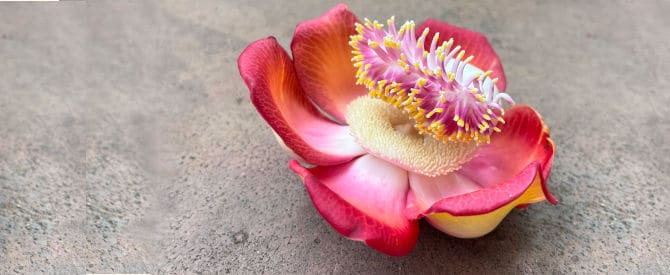I walked along a pathway amongst tall, mature trees swaying in the gentle breeze on a warm and sunny afternoon. Colourful birds joyfully sang above me. The subtle waft of fragrant incense drifted into my nostrils as the soulful sounds of a deep male voice continuously chanting “OM…” reverberated in the atmosphere around me. This was India.
I was on the grounds of the S-VYASA Yoga University in the suburbs of Bangalore. I was there for a one-month yoga instructor course in October 2023.
It was my first day there and I enjoyed taking in the natural beauty around me.
 Nature inspires us in the most magnificent ways. An example is the exquisite flower you see featured at the top of this article. It’s called naga lingam and has a wonderfully sweet fragrance. It comes from the Cannon Ball tree that produces some rather unusual fruits that are the size of five-pound bowling balls.
Nature inspires us in the most magnificent ways. An example is the exquisite flower you see featured at the top of this article. It’s called naga lingam and has a wonderfully sweet fragrance. It comes from the Cannon Ball tree that produces some rather unusual fruits that are the size of five-pound bowling balls.
The inner flesh of the fruit is used for medicinal purposes and the hard outer shells can be made into containers and utensils. In olden times, wandering yogis would shape them into water pots with handles called kamandalus.
Inspiration turns into alarm
Although nature provides beauty and inspiration, it’s not without its hazards…
When I moved into my room, I was amused to read a sign: “BEWARE OF MONKEYS. Please keep balcony doors and windows closed.”
My casual attitude soon turned into alarm when the girl in the room next door came over to say hello and told me to take this advice seriously. She had kept her window only very slightly open the day before and returned to find five monkeys creating havoc in her room! Apparently, they know how to break and enter.
Another student came along and cautioned me not to put out any small pieces of laundry to dry. He said monkeys had taken three of his boxers.
The same person also advised me to always keep food out of sight while walking around the campus. He told me he was chased by a monkey and became the victim of a snatch-and-run when he was walking out of the dining hall with a banana in his hand.
The monkeys were quite a problem. I got Wi-Fi for the first few days and no signal until the last two days of my thirty days there. I found out that monkeys had damaged the wires.
 They were everywhere, always looking for some way to find food and create mischief. Here’s one looking for an opening in the window at the library while I was there.
They were everywhere, always looking for some way to find food and create mischief. Here’s one looking for an opening in the window at the library while I was there.
It wasn’t just the monkeys we had to contend with. It was the beginning of October, and the rainy season wasn’t fully over here in the south of India.
Very many creatures emerged after the rains. It seemed that they were all lying dormant and in hiding until then.
Going for my 5 a.m. yoga class in the predawn darkness after the rains felt like I was navigating through a landmine. When I emerged from the elevator on the ground floor of the building where I was staying, I would invariably encounter nearly a dozen cockroaches on the ground. They were humongous! They lay there with their legs up in the air, convulsing, with varying degrees of life left in them. The caretakers of the building had obviously sprayed for these insects and now they were all flushed out by the rainwater.
And that’s not all, in the main hall where our yoga classes were held, frogs, lizards, rats and bats came out for all to see.
We found frogs and a bat on the floor struggling to find a way out after the rains. Once, when a student was giving his presentation, a rat literally ran past his heels right in front of our eyes.
One afternoon, a small lizard scampered about between our yoga mats, scaring some of the girls. And, there were so many dragonflies! I once bolted out of the toilet after finding one buzzing loudly above me.
Many unusual things are pretty normal in India.
 Here’s a painted sign outside a building showing the date of the last cleaning (January 2023) and the next scheduled date (June 2023). This photo was taken in October 2023. I wonder if the June cleaning was done? More importantly, what was being cleaned and why the painted sign? It remains a mystery to me and to all those whom I asked.
Here’s a painted sign outside a building showing the date of the last cleaning (January 2023) and the next scheduled date (June 2023). This photo was taken in October 2023. I wonder if the June cleaning was done? More importantly, what was being cleaned and why the painted sign? It remains a mystery to me and to all those whom I asked.
Now, you must be wondering…this is an article on inspirations from India. How are any of these quirky stories that I just shared inspiring?
But India is inspiring….
Inspiring India
The first thing that struck me about my India experience is that people are rooted in their culture. It is based on religious faith, respect for elders and family traditions.
I noticed in the early mornings, even when we had to be at our yoga class by 4.55 am, there would be a handful of classmates who had some white ash (from a sacrificial prayer) applied to their forehead, marking that they had done their prayers or meditation before coming. If it wasn’t at that early time, many of them would apply white ash or red powder on their foreheads after their showers later in the morning.
Most of my classmates at the yoga instructor course were in their twenties and thirties. They addressed older contemporaries respectfully as “Bhaiya” or “Didi” which mean “(older) brother” and “older sister”. I thought that was very sweet.
Since I was much older, they would address me as, “ma’am”. It felt a little strange, and I wasn’t entirely comfortable with it. I would have felt better being addressed as “Didi”, but I understood that they were coming from a place of respect.
When a teacher had finished teaching our class, we would remain sitting until he or she left the room. It would have been rude to get up and leave before that.
The teachers sat on a chair at the front of the hall, while we sat on our yoga mats on the parquet floor. Not sitting on the same level or higher than the teacher is a cultural habit that symbolically means an attitude of humility and respect for the teacher and the knowledge that is being shared. This habit has been passed down from the spiritual traditions of India.
Knowledge is revered and worshipped in India. That is why Goddess Saraswati, who is the embodiment of knowledge and wisdom, is worshipped.
The transferal of knowledge from the teacher to the student is compared to water that flows from a higher point to a lower one. For knowledge to be imbibed and lived by the student, he or she must have the attitude of humility and respect. These qualities are implied in the act of sitting at a lower level than the teacher.
We don’t normally think about the importance of humility in gaining knowledge, do we?
I was surprised to see how much the Indian teaching method relies on memorization and handwriting. We had to memorize mantras from the Patanjali Yoga Sutras, the Bhagavad Gita, mantras associated with our asanas and pranayama (breathing) practices, as well as the mantras chanted while doing the Surya Namaskar or Sun Salutations exercises.
It was challenging, but definitely a good practice. There is much to be said about the habit of memorizing mantras and other prayers. It uplifts the mind and keeps it healthy.
We were required to submit only handwritten reports. We were not allowed to submit our reports electronically. One of my classmates told me that this is a requirement even for medical students whose reports can be forty pages long.
I reflected on how in the west, while students can use calculators and computers, this reliance has eroded their ability to memorize and learn. In increasing their proficiency in typing, they are forgetting how to write with a pencil or a pen. Even though I protested having to handwrite my reports, I realised that writing connects my hand with my brain and heart. Writing by hand also allowed me to retain the study material better.
India is the birthplace of Yoga. Yoga is more than just physical postures. Sage Patanjali, who is well-known as The Father of Yoga, taught that yoga is the integration of the inner personality and final union with God, our own higher Self. This inner connection is nurtured daily in India.
People are brought up with stories from Hindu culture and legends that instill faith in God from a young age. There are temples in just about every street, and it’s common to hear prayers and devotional songs being sung as one walks by.
The S-Vyasa yoga university has a temple and a hall where we attended daily prayers, chanted mantras and sang devotional songs that nurtured the heart. Even the maintenance workers and other staff went to the prayer hall for prayers and chanting daily. I was inspired by the common purpose of uniting everyone in faith, divine love and prayer.
Accept and enjoy
Away from the bustling city, India felt like a throw-back to an earlier, simpler time. There was a raw, natural beauty. Things were not perfect, but that’s okay.
People in India generally take what would be considered as challenges in the west as facts of life. Here, nature and humans live together with plain acceptance. Whether it is in the countryside, the suburbs or in the busy cities, animals live side-by-side with humans. Cows, dogs, cats, and goats are common. It is what it is, as the popular phrase goes.
So what if there were monkeys? — Just remain cautious and learn to live with them. So, the rains bring out many creatures and insects. It is what it is. So, there are many idiosyncrasies (like the sign outside the building), laugh them off and move on.
Accept, accept, accept…accept them all and enjoy what is. They are all inspirations from India.
Like this post? Sign up for the free fortnightly Spiritual Solutions Newsletter and receive the latest articles, news and updates in your email inbox!














Your vivid descriptions and personal insights brought the beauty and complexity to life. I was especially touched by how you intertwined lessons from your yoga instructor course with broader cultural observations. Your writing is not only informative but also deeply reflective and engaging.
Thank you so much! Yes, India is beautiful and complex. I appreciate your kind comments about this article.